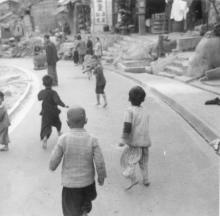Precious Blood Convent, Sham Shui Po [1929- ]
Primary tabs
Notes from AMO's "Brief information on proposed Grade II items":
Precious Blood Convent
No. 86 Un Chau Street, Sham Shui Po, Kowloon
Historical Interest
Established in 1929, the Convent of the Precious Blood (寶血女修院) was built for the Congregation of the Sisters of the Precious Blood (耶穌保血女修 會) after they gained independence from the Canossian Congregation in 1922. Over the past seven decades, the convent building has not only served as a private residence and summer retreat house for the Precious Blood Sisters, but also a symbol of charity, for the Sisters contributed to the well-being of Hong Kong society in the areas of education, social welfare and medical care.
The Convent was completed on 1 July 1929, and part of it was converted into an orphanage accommodating babies of destitute parents. The idea of a proper children’s hospital was raised on 25 July 1934 with the encouragement of Governor Sir William Peel who had previously visited the convent. The idea finally materialized in 1937 when the Precious Blood Hospital (寶血醫院) was opened through donations and the efforts of Bishop Henry Valtorta (恩理覺主教) and others. Part of the building served as an orphanage, and this continued well into 1952 when a new orphanage situated in Fanling (粉嶺) was completed.
Architectural Merit
The Precious Blood Convent is situated between two modern buildings,
the Precious Blood Hospital and the Tack Ching Girls’ Middle School (德貞女子中學), but blends in quite well due to its strictly symmetrical stripped-down Neo-Classical style with Neo-Georgian and Italianate Renaissance elements.
The main elevation facing Un Chau Street is finished with Shanghai rendering. The lower storey, and unusually the top storey, are rusticated with horizontal grooved joints to resemble stonework. The façade is symmetrically divided by pilasters into five bays. A simple classical portico and double-entry staircase form the entrance. The pilasters are raised off a projecting cornice or ledge at first floor level of beneath a wide projecting dentiled cornice in Italianate style at third floor level. There are two semi-circular Diocletian windows and, unusually for classical architecture, all the other windows are tripartite (divided into three parts), possibly a reference to the Holy Trinity. The boundary wall is built of coursed granite blocks featuring a Neo-Classical gateway with an Art Deco inspired pediment.
Rarity, Built Heritage Value & Authenticity
The Convent is quite a rare building type in the Sham Shui Po area. It has some unusual features which make it interesting and a valuable piece of built heritage. All the original windows appear to have been replaced with aluminum windows and there are some additions on the flat roof. Apart from that the building appears to be fairly authentic.
Social Value & Local Interest
Today, the Precious Blood Convent continues to contribute to the well-being of Hong Kong society. The Convent is situated in a small street community comprising two schools, a kindergarten, a hospital and a babies’ home and therefore has considerable social value as well as local interest.
Group Value
The other old sites in Sham Shui Po graded by the Antiquities Advisory Board include Mei Ho House (美荷樓, Grade I), Sam Tai Tsz Temple and Pak Tai Temple (三太之廟及北帝廟, Grade II), Sham Shui Po Police Station (深水埗警署, Grade III), Sham Shui Po Public Dispensary (深水埗醫局, Grade III), as well as a cluster of shophouses in Nam Cheong Street (南昌街, Grade II) and Yu Chau Street (汝洲街, Grade II). All these buildings have a good value from a heritage point of view.
Adaptive Re-use
Should the Convent ever cease to be used as a residence and summer retreat for the Sisters, presumably it could be converted into a useful annex for either the hospital or the school next door.
Remarks: Not yet graded
The Precious Blood Convent is one of the items recorded by the Antiquities and Monuments Office in view of its historical and architectural significance, but has not yet been graded as a historical building.


Photos that show this place